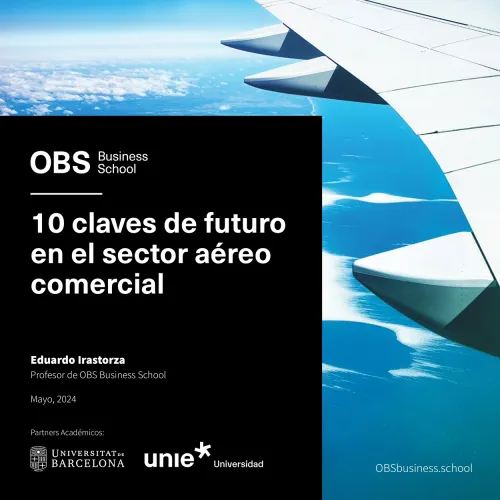
OBS Report: 10 keys to understand the future of the commercial airline industry
The European airline industry is threatened by Asian and South American airlines
- A strong internal market will help airlines to overcome the regular ups and downs in the international skies.
- Alliances between airlines and with complementary companies are essential to consolidate economies of scale and offer better services.
- Western airlines continue to lead the industry, but Turkish Airlines and China Southern Airlines are close behind with steady growth and backed by huge domestic traffic.
- There are new jets to reduce aircraft pollution, but it'll be a slow process due to the economic and geopolitical crisis.
May 2024. OBS Business School publishes the report 10 Keys to understand the future in the Commercial Airline Sector, directed by Professor Eduardo Irastorza. It analyses the sector from a broad perspective, assessing the factors that will determine its future and that will in many cases transform the paradigms that define it today.
The air transport industry began to earn profit again in 2023 after the pandemic setback; however, this year won't reach pre-2020 figures either. The current geopolitical, economic and energy crises do not facilitate this, air travel has become more complex over the last year and, as a consequence, safety has decreased. There are three major areas of conflict affecting the skies at the moment: Ukraine, which is reflected in much of Europe and North Asia, the Middle East, one of the world's busiest cargo areas, and the South China Sea, which influences the economies of China, Japan and North Korea. The consequence is that more airlines have to make long detours and establish new stopovers to keep reaching their destinations with higher fuel costs, reduced passenger and cargo numbers, as well as higher insurance rates. Today, the safest airlines are Etihad Airways, Emirates, KLM, Jetblue and Easy Jet.
This situation has a very negative impact on international flights and makes it clear to airlines that only a strong domestic market will help overcome the regular ups and downs of economic crises; hence the concentration process taking place in Europe. However, that advantage is also available to the new superpowers in a multipolar world and, while the US continues to dominate the skies, followed by Germany, France and the UK, the very dynamic Turkish Airlines and China Southern Airlines are close behind with steady growth and backed by their huge domestic traffic.
The historical hegemony of Western companies is being threatened by powerful Asian countries such as Japan, China, India, South Korea, the Philippines and Australia. But also by small states such as Singapore, the United Arab Emirates and Qatar. Not to mention others that are gaining strength in the periphery, such as Brazil, South Africa and Turkey. Moreover, there is already talk of a future single African air transport market, a project that is already a reality in five East African states.
The effects of aircraft pollution is another major concern on the table. Airlines are incorporating new jets, but the process will not be as fast as they would like, as the current economic and geopolitical crisis is not conducive to investment in a sector that is struggling to make a profit. However, governments are already talking about dates for the complete renewal of fleets and establishing dissuasive measures for those who do not comply. One easily implementable measure is to limit flights or even ban them, as France has done with short-haul flights, but this would be a drastic measure with serious consequences for the economy and employment, although welcomed by the ‘greener’ sector of society, says the report.
Another area of concern is punctuality, especially for long-haul flights. Asian and South American airlines use this element to compete with traditional Western airlines and gain the trust and preference of millions of people. Today, the most punctual long-haul airlines are Garuda Indonesia, Safair and Eurowings.
This is how travellers have changed
Consumers move between premium and low-cost brands, and the airline industry is no exception. However, while in the past customers used to opt for one model or the other, today everyone has access to both, depending on the moment. For this reason, Professor Irastorza believes that the ideal is to cover the entire offer with brands that coexist within the same group.
This income diversification strategy would also diversify risk, which is very necessary. In fact, large groups in the sector have been following this policy for some time. "What is clear is that simply talking about offering the best value for money is no longer a relevant argument in a sector in which specific advantages are so easily and quickly replicable", says Eduardo Irastorza.
Sector developments
To compete successfully in today's skies, it is essential to establish alliances to consolidate economies of scale. This is the strategic decision taken by many major airlines, especially in Europe, where the domestic market is not sufficient to compete with the new and overcrowded emerging powers. Three concepts will determine success in the field of marketing: Brand Experience, i.e. all the experiences that the customer establishes with the brand, something that increasingly involves establishing alliances with complementary companies so that passengers can enjoy exclusive experiences; Lifetime Value, i.e. the management of customer who interact with our brand, which has become easier and more profitable thanks to Big Data tools; and Frontline, i.e. the need to establish direct and personalised contact with the customer. The great advantage of those who occupy the Frontline is the enormous capital of knowledge they have of the customer and the possibility of making cross-proposals, proactive and efficient. According to Eduardo Irastorza: "In the future there will only be two types of brands: those that have conquered the Frontline and the rest, which will struggle to survive".
Regarding the human resources of airlines, the report highlights that for decades, flight staff have been dedicated to providing an exceptional experience for travelers. They undergo continuous updates, maintaining very high quality standards. However, challenges persist on the ground. Airlines still struggle with incidents, lost baggage, and delays in departures and arrivals, and they are increasingly burdened by the costs of flight cancellations. Marjan Rintel, Executive Director of KLM, advocates for the taxes imposed on airlines to be reinvested within the industry rather than being allocated elsewhere. The report emphasizes that airlines must have experts in customer management, leveraging CRM and Big Data resources. Whether these experts are in-house or external, they should be managed with a long-term, holistic approach. Only by combining these human and technological resources can airlines enhance their influence, as mere efficiency will not suffice for survival.
In customer management, airlines must also recognize the significant impact of social networks. Engaging in conversations, creating compelling content, and leveraging endorsements from influential figures and respected experts will be crucial for attracting, serving, and retaining customers. "Perhaps until now, we have not considered them as part of the crew, but the community manager and their team are indeed part of the crew," says Irastorza.
Content written by:
Carmen García-Trevijano
OBS Business School Press Office

